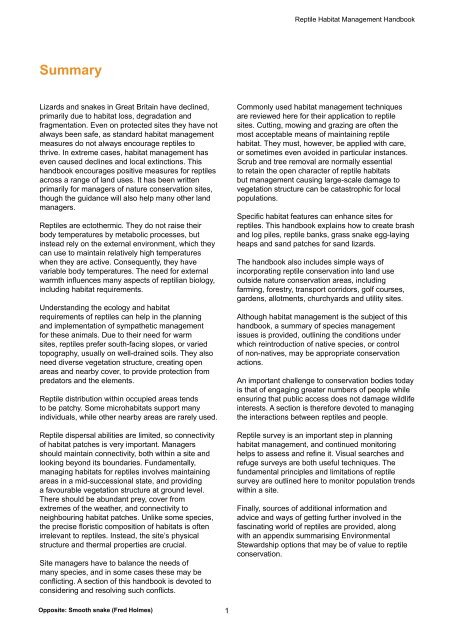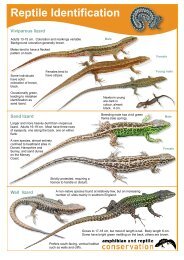reptile-habitat-management-handbook-ffull
reptile-habitat-management-handbook-ffull
reptile-habitat-management-handbook-ffull
Create successful ePaper yourself
Turn your PDF publications into a flip-book with our unique Google optimized e-Paper software.
Reptile Habitat Management Handbook<br />
Summary<br />
Lizards and snakes in Great Britain have declined,<br />
primarily due to <strong>habitat</strong> loss, degradation and<br />
fragmentation. Even on protected sites they have not<br />
always been safe, as standard <strong>habitat</strong> <strong>management</strong><br />
measures do not always encourage <strong>reptile</strong>s to<br />
thrive. In extreme cases, <strong>habitat</strong> <strong>management</strong> has<br />
even caused declines and local extinctions. This<br />
<strong>handbook</strong> encourages positive measures for <strong>reptile</strong>s<br />
across a range of land uses. It has been written<br />
primarily for managers of nature conservation sites,<br />
though the guidance will also help many other land<br />
managers.<br />
Reptiles are ectothermic. They do not raise their<br />
body temperatures by metabolic processes, but<br />
instead rely on the external environment, which they<br />
can use to maintain relatively high temperatures<br />
when they are active. Consequently, they have<br />
variable body temperatures. The need for external<br />
warmth influences many aspects of reptilian biology,<br />
including <strong>habitat</strong> requirements.<br />
Understanding the ecology and <strong>habitat</strong><br />
requirements of <strong>reptile</strong>s can help in the planning<br />
and implementation of sympathetic <strong>management</strong><br />
for these animals. Due to their need for warm<br />
sites, <strong>reptile</strong>s prefer south-facing slopes, or varied<br />
topography, usually on well-drained soils. They also<br />
need diverse vegetation structure, creating open<br />
areas and nearby cover, to provide protection from<br />
predators and the elements.<br />
Reptile distribution within occupied areas tends<br />
to be patchy. Some micro<strong>habitat</strong>s support many<br />
individuals, while other nearby areas are rarely used.<br />
Reptile dispersal abilities are limited, so connectivity<br />
of <strong>habitat</strong> patches is very important. Managers<br />
should maintain connectivity, both within a site and<br />
looking beyond its boundaries. Fundamentally,<br />
managing <strong>habitat</strong>s for <strong>reptile</strong>s involves maintaining<br />
areas in a mid-successional state, and providing<br />
a favourable vegetation structure at ground level.<br />
There should be abundant prey, cover from<br />
extremes of the weather, and connectivity to<br />
neighbouring <strong>habitat</strong> patches. Unlike some species,<br />
the precise floristic composition of <strong>habitat</strong>s is often<br />
irrelevant to <strong>reptile</strong>s. Instead, the site’s physical<br />
structure and thermal properties are crucial.<br />
Site managers have to balance the needs of<br />
many species, and in some cases these may be<br />
conflicting. A section of this <strong>handbook</strong> is devoted to<br />
considering and resolving such conflicts.<br />
Commonly used <strong>habitat</strong> <strong>management</strong> techniques<br />
are reviewed here for their application to <strong>reptile</strong><br />
sites. Cutting, mowing and grazing are often the<br />
most acceptable means of maintaining <strong>reptile</strong><br />
<strong>habitat</strong>. They must, however, be applied with care,<br />
or sometimes even avoided in particular instances.<br />
Scrub and tree removal are normally essential<br />
to retain the open character of <strong>reptile</strong> <strong>habitat</strong>s<br />
but <strong>management</strong> causing large-scale damage to<br />
vegetation structure can be catastrophic for local<br />
populations.<br />
Specific <strong>habitat</strong> features can enhance sites for<br />
<strong>reptile</strong>s. This <strong>handbook</strong> explains how to create brash<br />
and log piles, <strong>reptile</strong> banks, grass snake egg-laying<br />
heaps and sand patches for sand lizards.<br />
The <strong>handbook</strong> also includes simple ways of<br />
incorporating <strong>reptile</strong> conservation into land use<br />
outside nature conservation areas, including<br />
farming, forestry, transport corridors, golf courses,<br />
gardens, allotments, churchyards and utility sites.<br />
Although <strong>habitat</strong> <strong>management</strong> is the subject of this<br />
<strong>handbook</strong>, a summary of species <strong>management</strong><br />
issues is provided, outlining the conditions under<br />
which reintroduction of native species, or control<br />
of non-natives, may be appropriate conservation<br />
actions.<br />
An important challenge to conservation bodies today<br />
is that of engaging greater numbers of people while<br />
ensuring that public access does not damage wildlife<br />
interests. A section is therefore devoted to managing<br />
the interactions between <strong>reptile</strong>s and people.<br />
Reptile survey is an important step in planning<br />
<strong>habitat</strong> <strong>management</strong>, and continued monitoring<br />
helps to assess and refine it. Visual searches and<br />
refuge surveys are both useful techniques. The<br />
fundamental principles and limitations of <strong>reptile</strong><br />
survey are outlined here to monitor population trends<br />
within a site.<br />
Finally, sources of additional information and<br />
advice and ways of getting further involved in the<br />
fascinating world of <strong>reptile</strong>s are provided, along<br />
with an appendix summarising Environmental<br />
Stewardship options that may be of value to <strong>reptile</strong><br />
conservation.<br />
Opposite: Smooth snake (Fred Holmes)<br />
1



